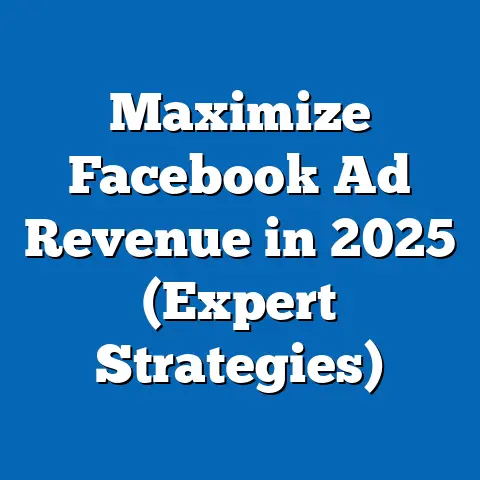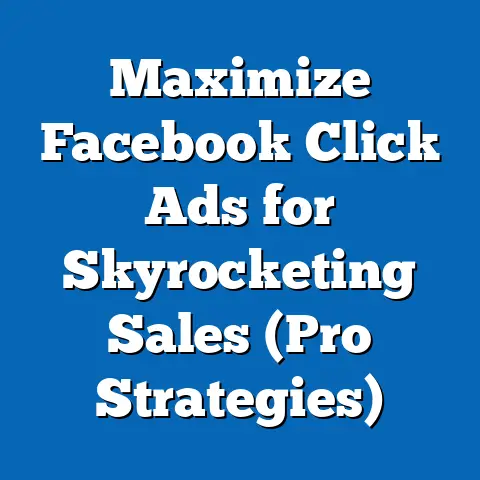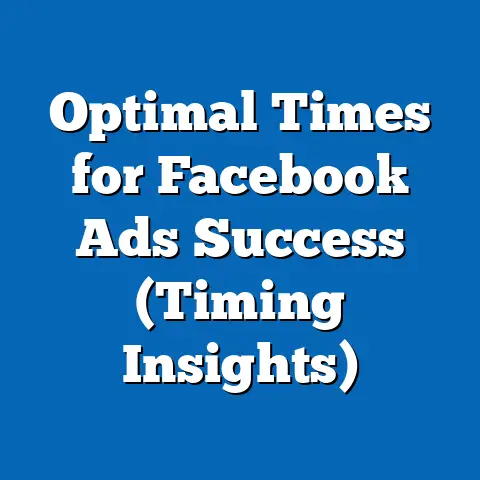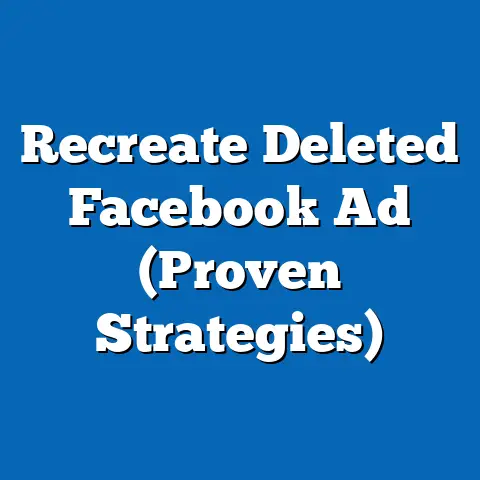Why Appealing Facebook Ad Rejections Matters (Strategic Insight)
Why Appealing Facebook Ad Rejections Matters: Strategic Insight
Imagine this: you’re sipping a latte on a sun-drenched balcony, overlooking the turquoise waters of the Mediterranean. Or perhaps you’re hiking through the lush landscapes of New Zealand, completely untethered from the constraints of a 9-to-5 job. Maybe your dream involves spending more quality time with family, pursuing a passion project, or simply having the financial freedom to live life on your own terms.
What does your ideal lifestyle look like? Really picture it.
For many, achieving these aspirations hinges on building a successful business or generating passive income streams. And in today’s digital landscape, that often means harnessing the power of online advertising, especially on platforms like Facebook.
Facebook, with its billions of users and sophisticated targeting capabilities, presents an unparalleled opportunity to reach potential customers and grow your business. But here’s the catch: navigating the world of Facebook Ads can be tricky. One of the most frustrating hurdles entrepreneurs and marketers face is the dreaded ad rejection.
It’s happened to me, and I’m sure it’s happened to you. You pour your heart and soul into crafting the perfect ad, only to have it rejected by Facebook’s seemingly arbitrary algorithms. It’s enough to make you want to throw your laptop out the window!
But before you succumb to despair, I want to share a secret: appealing Facebook ad rejections isn’t just a necessary evil; it’s a strategic move that can significantly impact your overall digital marketing success. In this article, I’m going to walk you through why appealing rejections is so important, how to craft a compelling appeal, and how to turn rejections into valuable learning opportunities.
Think of it this way: appealing rejections is like learning to surf. You’re going to wipe out a few times (or maybe a lot!), but each time you get back on the board, you’re learning something new. You’re understanding the waves, adjusting your technique, and getting closer to that perfect ride. Similarly, each time you appeal a rejection, you’re gaining a deeper understanding of Facebook’s ad ecosystem, refining your messaging, and ultimately improving your ad performance.
So, let’s embark on this journey together and unlock the strategic power of appealing Facebook ad rejections. It’s time to turn those setbacks into stepping stones towards achieving your lifestyle aspirations.
Section 1: Understanding Facebook Ad Rejections
Facebook’s advertising platform is a complex ecosystem, governed by a comprehensive set of guidelines and policies. These rules are designed to protect users from misleading, offensive, or harmful content. While the intention is noble, the sheer volume of ads processed daily means that even well-intentioned marketers can find themselves on the receiving end of a rejection.
When I first started running Facebook ads, I was completely overwhelmed by the sheer number of rules and regulations. It felt like trying to navigate a minefield blindfolded. I quickly learned that understanding these guidelines is crucial to avoiding rejections in the first place.
The Labyrinthine World of Facebook Ad Policies
Facebook’s ad policies cover a wide range of topics, including:
- Prohibited Content: This includes anything that promotes illegal activities, discrimination, violence, or hate speech. It also prohibits the sale of certain products and services, such as drugs, weapons, and counterfeit goods.
- Restricted Content: This category includes content that requires special authorization or targeting limitations. Examples include ads for alcohol, gambling, and dating services.
- Personal Attributes: Ads cannot directly or indirectly assert or imply personal attributes such as race, ethnicity, religion, age, sexual orientation, gender identity, disability, or medical condition.
- Misleading or Deceptive Content: Ads must be accurate and truthful. They cannot make false claims, use deceptive tactics, or promote scams.
- Sensational Content: Ads should not contain shocking, sensational, disrespectful, or excessively violent content.
- Grammar and Punctuation: Ads must adhere to proper grammar and punctuation. Excessive use of symbols, emojis, or all caps is often frowned upon.
- Landing Page Experience: The landing page associated with your ad must be functional, relevant, and easy to navigate. It should also align with the promises made in your ad.
This list is just the tip of the iceberg. Facebook’s ad policies are constantly evolving to address new challenges and protect its users. Staying up-to-date with these changes is an ongoing process, requiring diligent attention and a willingness to adapt.
Common Reasons for Ad Rejections
Even with a thorough understanding of Facebook’s ad policies, rejections can still happen. Here are some of the most common reasons why ads get flagged:
- Violating the 20% Text Rule (Now Largely Obsolete but Still Relevant): In the past, Facebook limited the amount of text that could appear in an ad image to 20%. While this rule is no longer strictly enforced, ads with excessive text may still experience reduced reach or higher costs.
- Making Unsubstantiated Claims: Ads that make bold claims about a product or service without providing sufficient evidence are likely to be rejected. For example, claiming that your weight loss product can help people lose 20 pounds in a week without scientific backing is a red flag.
- Using Inappropriate Imagery: Ads that contain sexually suggestive, violent, or otherwise offensive images are strictly prohibited.
- Targeting Sensitive Topics: Ads that target users based on sensitive personal attributes, such as medical conditions or financial difficulties, are likely to be rejected.
- Promoting Low-Quality or Misleading Products/Services: Facebook takes a dim view of ads that promote scams, pyramid schemes, or products that are known to be ineffective or harmful.
- Non-Functional Landing Pages: If your ad directs users to a broken or irrelevant landing page, it will likely be rejected.
- Circumventing Systems: Attempting to bypass Facebook’s ad review process through cloaking, URL redirects, or other deceptive tactics is a surefire way to get your ads rejected and potentially have your account suspended.
One time, I was running an ad for a new software tool that promised to help businesses automate their social media marketing. I used the phrase “skyrocket your engagement” in the ad copy. While I didn’t think it was a particularly outlandish claim, Facebook flagged it as misleading and rejected the ad. I learned that even seemingly harmless language can trigger a rejection if it’s perceived as being too hyperbolic or unsubstantiated.
The Impact of Ad Rejections on Businesses
Ad rejections can have a significant impact on businesses of all sizes. Here are some of the most common consequences:
- Lost Revenue Opportunities: When your ads are rejected, you’re missing out on the chance to reach potential customers and generate sales. This can be particularly damaging for businesses that rely heavily on Facebook advertising for their revenue.
- Disruption of Marketing Campaigns: Ad rejections can throw a wrench into your carefully planned marketing campaigns. They can delay launches, disrupt momentum, and force you to scramble to find alternative solutions.
- Increased Costs: If your ads are frequently rejected, you may experience higher advertising costs. Facebook may penalize accounts with a history of policy violations by increasing the cost per click or reducing the reach of their ads.
- Account Suspension: In severe cases, repeated violations of Facebook’s ad policies can lead to account suspension or even permanent banishment from the platform. This can be a devastating blow for businesses that depend on Facebook advertising.
- Damage to Brand Reputation: If your ads are consistently rejected for violating Facebook’s policies, it can damage your brand’s reputation. Customers may perceive your business as being untrustworthy or unethical.
Ad rejections can be a major headache for businesses, but they don’t have to be a death sentence. By understanding Facebook’s ad policies, avoiding common pitfalls, and learning how to craft effective appeals, you can minimize the impact of rejections and keep your advertising campaigns on track.
Takeaway: Facebook’s ad policies are complex and constantly evolving. Understanding these guidelines is crucial to avoiding rejections and minimizing their impact on your business.
Next Steps: Familiarize yourself with Facebook’s ad policies and identify any potential violations in your current ads.
Section 2: The Emotional and Financial Impact of Ad Rejections
Beyond the logistical and financial repercussions, ad rejections can take a significant emotional toll on business owners and marketers. I’ve seen it firsthand, and I’ve experienced it myself. You pour your heart and soul into crafting an ad, believing it will resonate with your target audience and drive results. Then, you get that dreaded notification: “Your ad has been rejected.”
It’s like a punch to the gut.
The Emotional Rollercoaster of Ad Rejections
The emotional impact of ad rejections can manifest in a variety of ways:
- Frustration: You’ve spent hours crafting the perfect ad, only to have it rejected for seemingly arbitrary reasons. This can lead to feelings of frustration and helplessness.
- Disappointment: You had high hopes for your ad campaign, and the rejection feels like a major setback. This can lead to feelings of disappointment and discouragement.
- Self-Doubt: You start to question your abilities as a marketer. Are you doing something wrong? Are you out of touch with your target audience?
- Anger: You may feel angry at Facebook for its seemingly unfair policies and its lack of transparency in the ad review process.
- Stress: Ad rejections can add to the already considerable stress of running a business. You may feel pressured to fix the problem quickly and get your ads back online.
I remember one time when I was launching a new product for my business. I had invested a significant amount of time and money into creating the perfect ad campaign. When the ads were rejected, I felt like all my hard work had been for nothing. I was stressed, frustrated, and filled with self-doubt. It took me a while to regain my composure and figure out how to fix the problem.
The Financial Fallout of Rejected Ads
The financial implications of ad rejections can be just as damaging as the emotional ones. Here are some of the most common financial consequences:
- Wasted Ad Spend: When your ads are rejected, you’re essentially throwing money away. You’ve paid to create and run ads that aren’t reaching your target audience.
- Lost Sales: Ad rejections can lead to lost sales and revenue. If your ads aren’t running, you’re not generating leads or driving conversions.
- Delayed Launches: Ad rejections can delay product launches and marketing campaigns, costing you valuable time and money.
- Increased Marketing Costs: If your ads are frequently rejected, you may need to spend more money on marketing to compensate for the lost reach and engagement.
- Damage to Brand Value: If your ads are consistently rejected for violating Facebook’s policies, it can damage your brand’s reputation and erode customer trust, ultimately impacting your bottom line.
According to a study by HubSpot, businesses lose an average of \$9.4 million per year due to poor marketing practices, including ineffective advertising campaigns. While ad rejections are just one aspect of poor marketing, they can certainly contribute to this staggering figure.
Stalled Growth and Hindered Lifestyle Goals
Ultimately, the emotional and financial impact of ad rejections can stall your business growth and hinder your ability to achieve your lifestyle goals. If you’re constantly battling ad rejections, you’re not able to focus on the things that truly matter: building your business, serving your customers, and living the life you’ve always dreamed of.
It’s like trying to climb a mountain with a heavy backpack filled with rocks. The ad rejections are the rocks, weighing you down and making it harder to reach the summit.
That’s why it’s so important to develop a resilient mindset and a strategic approach to dealing with ad rejections. You need to learn how to turn those setbacks into learning opportunities and keep moving forward towards your goals.
Takeaway: Ad rejections can have a significant emotional and financial impact on businesses, stalling growth and hindering the achievement of lifestyle goals.
Next Steps: Reflect on your own experiences with ad rejections and identify the emotional and financial costs you’ve incurred.
Section 3: The Strategic Importance of Appealing Rejections
Now that we’ve established the challenges and frustrations associated with Facebook ad rejections, let’s talk about the strategic importance of appealing them. Appealing rejections isn’t just about getting a single ad approved; it’s about gaining a deeper understanding of Facebook’s ad ecosystem, refining your messaging, and ultimately improving your overall advertising performance.
I used to think that appealing rejections was a waste of time. I figured that Facebook’s algorithms were infallible and that there was no point in arguing with them. But I quickly learned that this was a mistake. Appealing rejections can be a valuable learning experience and a powerful tool for improving your advertising strategy.
Unlocking the Benefits of Appealing
Here are some of the key benefits of appealing Facebook ad rejections:
- Learning and Understanding: The appeal process forces you to carefully review your ad and identify any potential violations of Facebook’s policies. This can help you gain a better understanding of the platform’s rules and regulations.
- Refining Messaging: By appealing rejections, you have the opportunity to explain your ad’s intent and clarify any potential misunderstandings. This can help you refine your messaging and make it more compliant with Facebook’s policies.
- Improved Ad Performance: Appealing rejections can lead to improved ad performance. If your appeal is successful, your ad will be approved and you’ll be able to reach your target audience. Even if your appeal is unsuccessful, the process of reviewing and refining your ad can help you create more effective campaigns in the future.
- Building a Relationship with Facebook: Appealing rejections can help you build a relationship with Facebook’s ad review team. By engaging in a constructive dialogue, you can demonstrate your commitment to following the platform’s policies and improve your chances of getting your ads approved in the future.
- Challenging Inaccurate Rejections: Sometimes, Facebook’s algorithms make mistakes and reject ads that are actually compliant with the platform’s policies. Appealing these rejections allows you to challenge these inaccurate decisions and get your ads back online.
According to a study by AdEspresso, businesses that appeal Facebook ad rejections have a 20% higher success rate than those that don’t. This demonstrates the power of appealing and the potential for significant improvements in ad performance.
Understanding Facebook’s Ad Ecosystem
The more you appeal, the more you learn about the nuances of Facebook’s ad ecosystem. You start to understand what triggers the algorithms, what language is acceptable, and what types of visuals are likely to be approved. This knowledge is invaluable for creating more effective and compliant ads in the future.
It’s like learning a new language. The more you practice, the more fluent you become. Similarly, the more you appeal rejections, the more fluent you become in the language of Facebook Ads.
Examples of Successful Appeals
Here are a few examples of successful appeals and the positive outcomes that followed:
- A fitness company’s ad was rejected for making unsubstantiated claims about weight loss. The company appealed the rejection, providing scientific evidence to support its claims. Facebook approved the appeal, and the company was able to run its ad campaign successfully, generating a significant number of leads and sales.
- A local restaurant’s ad was rejected for using an image that violated Facebook’s policy on personal attributes. The restaurant appealed the rejection, explaining that the image was intended to showcase the diversity of its customer base and not to target users based on their race or ethnicity. Facebook approved the appeal, and the restaurant was able to continue running its ad campaign, attracting new customers from all backgrounds.
- A software company’s ad was rejected for using language that was deemed too hyperbolic. The company appealed the rejection, explaining that the language was intended to be playful and engaging and not to mislead users. Facebook approved the appeal, and the company was able to run its ad campaign successfully, generating a significant amount of buzz and excitement around its new product.
These examples demonstrate that appealing rejections can be a worthwhile endeavor. By carefully reviewing your ad, explaining your intent, and providing supporting evidence, you can often overturn inaccurate rejections and get your ads back online.
Takeaway: Appealing Facebook ad rejections is a strategic move that can lead to improved ad performance, a deeper understanding of Facebook’s ad ecosystem, and the opportunity to challenge inaccurate rejections.
Next Steps: Identify any rejected ads in your account and consider appealing them, focusing on the potential benefits and learning opportunities.
Section 4: Crafting a Compelling Appeal
Now that you understand the strategic importance of appealing Facebook ad rejections, let’s talk about how to craft a compelling appeal that will increase your chances of success. A well-crafted appeal is clear, professional, and constructive. It demonstrates that you understand Facebook’s policies and that you’re committed to following them.
I’ve learned that the key to a successful appeal is to be respectful and persuasive. You’re not trying to argue with Facebook; you’re trying to educate them and convince them that your ad is compliant with their policies.
A Step-by-Step Guide to Crafting an Effective Appeal
Here’s a step-by-step guide to crafting an effective appeal for a rejected Facebook ad:
- Review the Rejection Reason: Carefully read the reason for the rejection provided by Facebook. Make sure you understand exactly why your ad was flagged.
- Analyze Your Ad: Review your ad and identify any potential violations of Facebook’s policies. Be honest with yourself and try to see your ad from Facebook’s perspective.
- Craft Your Appeal: Write a clear, concise, and professional appeal that addresses the specific reason for the rejection.
- Explain Your Intent: Explain the intent of your ad and clarify any potential misunderstandings.
- Provide Supporting Evidence: If possible, provide supporting evidence to demonstrate that your ad is compliant with Facebook’s policies. This could include scientific studies, customer testimonials, or screenshots of your landing page.
- Maintain a Constructive Tone: Avoid being argumentative or accusatory. Instead, focus on educating Facebook and demonstrating your commitment to following their policies.
- Proofread Your Appeal: Before submitting your appeal, proofread it carefully to ensure that it’s free of errors and typos.
The Importance of Clarity, Professionalism, and a Constructive Tone
Clarity, professionalism, and a constructive tone are essential for crafting an effective appeal. Here’s why:
- Clarity: Your appeal should be easy to understand. Use clear, concise language and avoid jargon or technical terms.
- Professionalism: Your appeal should be professional and respectful. Avoid using slang, profanity, or other inappropriate language.
- Constructive Tone: Your appeal should be constructive and solution-oriented. Focus on explaining your intent and providing supporting evidence, rather than arguing or accusing Facebook.
I once received a rejection for an ad that I thought was perfectly compliant with Facebook’s policies. I was tempted to write an angry, accusatory appeal. But I knew that this wouldn’t be effective. Instead, I took a deep breath and crafted a clear, professional, and constructive appeal that explained my intent and provided supporting evidence. To my surprise, Facebook approved the appeal, and my ad was back online within hours.
Communicating Intent and Value
When crafting your appeal, it’s important to effectively communicate the intent and value of your ad. Explain how your ad benefits users and why it’s relevant to their interests. This can help Facebook understand your ad’s purpose and see that it’s not intended to mislead or deceive users.
For example, if you’re running an ad for a new software tool, you might explain how the tool helps businesses save time and money, improve their productivity, or achieve their marketing goals. You could also provide customer testimonials or case studies to demonstrate the value of your tool.
Addressing Specific Reasons for Rejection
Your appeal should directly address the specific reason for the rejection provided by Facebook. Don’t try to sidestep the issue or make excuses. Instead, acknowledge the problem and explain how you’ve addressed it.
For example, if your ad was rejected for violating Facebook’s policy on personal attributes, you might explain that you’ve removed any language or imagery that could be interpreted as targeting users based on their race, ethnicity, or other sensitive attributes.
Examples of Well-Crafted Appeals
Here are a few examples of well-crafted appeals that have led to successful ad approvals:
- Original Rejection Reason: “Your ad violates our policy on personal attributes.”
- Appeal: “We understand that our ad may have been misinterpreted as targeting users based on their race. We have removed the image that was causing concern and have revised the ad copy to ensure that it does not contain any language that could be construed as discriminatory. Our intent was to showcase the diversity of our customer base and not to target users based on their race.”
- Original Rejection Reason: “Your ad makes unsubstantiated claims about weight loss.”
- Appeal: “We understand that our ad may have contained language that was deemed too hyperbolic. We have revised the ad copy to remove any unsubstantiated claims about weight loss. We have also included links to scientific studies that support the effectiveness of our product. Our intent was to provide accurate and truthful information about our product and not to mislead users.”
- Original Rejection Reason: “Your ad directs users to a non-functional landing page.”
- Appeal: “We apologize for the inconvenience. We have fixed the issue with our landing page and have verified that it is now functional. We have also reviewed the landing page to ensure that it aligns with the promises made in our ad. Our intent was to provide users with a seamless and informative experience.”
- Appeal: “We understand that our ad may have been misinterpreted as targeting users based on their race. We have removed the image that was causing concern and have revised the ad copy to ensure that it does not contain any language that could be construed as discriminatory. Our intent was to showcase the diversity of our customer base and not to target users based on their race.”
- Appeal: “We understand that our ad may have contained language that was deemed too hyperbolic. We have revised the ad copy to remove any unsubstantiated claims about weight loss. We have also included links to scientific studies that support the effectiveness of our product. Our intent was to provide accurate and truthful information about our product and not to mislead users.”
- Appeal: “We apologize for the inconvenience. We have fixed the issue with our landing page and have verified that it is now functional. We have also reviewed the landing page to ensure that it aligns with the promises made in our ad. Our intent was to provide users with a seamless and informative experience.”
These examples demonstrate that a clear, professional, and constructive appeal can often lead to a successful outcome. By taking the time to craft a compelling appeal, you can increase your chances of getting your ads approved and reaching your target audience.
Takeaway: Crafting a compelling appeal involves clarity, professionalism, and a constructive tone. It’s about effectively communicating your intent, addressing specific reasons for rejection, and providing supporting evidence.
Next Steps: Review the rejected ads in your account and practice crafting compelling appeals for each one, focusing on clarity, professionalism, and a constructive tone.
Section 5: Learning from Rejections
Ad rejections can be frustrating, but they can also be valuable learning opportunities. By analyzing rejected ads, you can gain insights into Facebook’s policies, refine your messaging, and improve your overall advertising strategy.
I’ve come to view ad rejections as free feedback from Facebook. It’s like having a team of experts review your ads and tell you what you’re doing wrong. The key is to be open to the feedback and use it to improve your future campaigns.
Viewing Ad Rejections as Learning Opportunities
Instead of dwelling on the negative aspects of ad rejections, try to view them as learning opportunities. Ask yourself:
- What can I learn from this rejection?
- What could I have done differently?
- How can I avoid similar rejections in the future?
By asking these questions, you can turn ad rejections into valuable lessons that will help you become a more effective marketer.
Analyzing Rejected Ads
When analyzing rejected ads, pay attention to the following:
- The Rejection Reason: Carefully review the reason for the rejection provided by Facebook. Make sure you understand exactly why your ad was flagged.
- The Ad Copy: Analyze your ad copy and identify any language that could be interpreted as violating Facebook’s policies. Look for unsubstantiated claims, personal attributes, or other problematic phrases.
- The Ad Creative: Review your ad creative and identify any images or videos that could be considered offensive, misleading, or inappropriate.
- The Targeting: Analyze your targeting and make sure that you’re not targeting users based on sensitive personal attributes.
- The Landing Page: Review your landing page and ensure that it’s functional, relevant, and easy to navigate.
By carefully analyzing these elements, you can gain a better understanding of why your ad was rejected and what you can do to fix it.
Better Targeting, Creative Strategies, and Messaging
Analyzing rejected ads can lead to improvements in your targeting, creative strategies, and messaging. Here’s how:
- Targeting: By analyzing rejected ads, you can identify any targeting parameters that may be violating Facebook’s policies. This can help you refine your targeting and avoid similar rejections in the future.
- Creative Strategies: By reviewing your ad creative, you can identify any images or videos that may be considered offensive, misleading, or inappropriate. This can help you develop more compliant and effective creative strategies.
- Messaging: By analyzing your ad copy, you can identify any language that may be violating Facebook’s policies. This can help you refine your messaging and create more compliant and persuasive ads.
I once had an ad rejected for using an image that was deemed too sexually suggestive. I was surprised because I didn’t think the image was particularly racy. But after reviewing Facebook’s policies, I realized that the image violated their guidelines on sexual content. I replaced the image with a more appropriate one, and the ad was approved. This experience taught me the importance of carefully reviewing my ad creative and ensuring that it complies with Facebook’s policies.
Gathering Feedback and Iterating on Ad Content
In addition to analyzing rejected ads yourself, you can also gather feedback from others. Ask your colleagues, friends, or family members to review your ads and provide their honest opinions. This can help you identify any potential problems that you may have missed.
Once you’ve gathered feedback, use it to iterate on your ad content. Make changes to your ad copy, creative, targeting, or landing page based on the feedback you’ve received. Then, resubmit your ad for review.
The process of gathering feedback and iterating on ad content can be time-consuming, but it’s well worth the effort. By continuously improving your ads, you can increase your chances of getting them approved and achieving your advertising goals.
Takeaway: Ad rejections can be valuable learning opportunities. By analyzing rejected ads, you can gain insights into Facebook’s policies, refine your messaging, and improve your overall advertising strategy.
Next Steps: Review your rejected ads and identify specific areas for improvement in your targeting, creative strategies, and messaging.
Section 6: Building Resilience in Advertising
Advertising, like any endeavor, is fraught with challenges and setbacks. From ad rejections to fluctuating costs to algorithm changes, there are plenty of obstacles that can derail your progress. That’s why it’s so important to build resilience in advertising.
Resilience is the ability to bounce back from adversity and keep moving forward towards your goals. It’s the mental toughness that allows you to persevere in the face of challenges and setbacks.
I’ve learned that resilience is one of the most important qualities for a successful marketer. You’re going to face rejection, criticism, and failure along the way. The key is to not let these setbacks define you. Instead, use them as opportunities to learn, grow, and become even better.
The Psychological Aspects of Resilience
Resilience is not just about being tough or stubborn. It’s about having a positive mindset, a strong sense of self-efficacy, and the ability to adapt to change.
Here are some of the key psychological aspects of resilience:
- Optimism: Resilient people tend to be optimistic. They believe that things will get better and that they have the ability to overcome challenges.
- Self-Efficacy: Resilient people have a strong sense of self-efficacy. They believe that they have the skills and abilities to succeed.
- Adaptability: Resilient people are adaptable. They’re able to adjust to change and find new ways to achieve their goals.
- Problem-Solving Skills: Resilient people are good problem-solvers. They’re able to identify problems, analyze them, and develop effective solutions.
- Social Support: Resilient people have strong social support networks. They have people they can turn to for help and encouragement.
Developing a Resilient Mindset
Developing a resilient mindset is essential for navigating the challenges of advertising. Here are some tips for building resilience:
- Focus on What You Can Control: There are many things in advertising that you can’t control, such as Facebook’s algorithms or the behavior of your competitors. Focus on the things you can control, such as your ad copy, creative, targeting, and landing page.
- Learn from Your Mistakes: Everyone makes mistakes. The key is to learn from them and avoid making the same mistakes again.
- Celebrate Your Successes: Take time to celebrate your successes, no matter how small. This will help you stay motivated and focused on your goals.
- Seek Support: Don’t be afraid to ask for help when you need it. Talk to your colleagues, friends, or family members about your challenges and seek their support.
- Practice Self-Care: Take care of your physical and mental health. Get enough sleep, eat healthy foods, and exercise regularly.
Maintaining Motivation and Focus
Maintaining motivation and focus is crucial for achieving your long-term lifestyle goals. Here are some strategies for staying motivated and focused:
- Set Clear Goals: Set clear, specific, and measurable goals. This will help you stay focused on what you’re trying to achieve.
- Break Down Large Goals: Break down large goals into smaller, more manageable tasks. This will make them less daunting and easier to achieve.
- Track Your Progress: Track your progress towards your goals. This will help you see how far you’ve come and stay motivated.
- Reward Yourself: Reward yourself when you achieve your goals. This will reinforce positive behavior and keep you motivated.
- Visualize Your Success: Visualize yourself achieving your goals. This will help you stay focused and motivated.
Remember that building resilience is an ongoing process. It takes time, effort, and commitment. But by developing a resilient mindset and practicing these strategies, you can overcome the challenges of advertising and achieve your long-term lifestyle goals.
Takeaway: Building resilience in advertising is essential for navigating challenges and setbacks. Developing a resilient mindset involves optimism, self-efficacy, adaptability, problem-solving skills, and strong social support.
Next Steps: Reflect on your own resilience and identify areas where you can improve. Practice the strategies outlined in this section to build a more resilient mindset.
Conclusion
We’ve covered a lot of ground in this article, from understanding Facebook’s ad policies to crafting compelling appeals to building resilience in advertising. I hope you’ve gained a deeper appreciation for the strategic importance of appealing Facebook ad rejections.
It’s not just about getting individual ads approved; it’s about gaining a deeper understanding of Facebook’s ad ecosystem, refining your messaging, and ultimately improving your overall advertising performance. It’s about turning setbacks into learning opportunities and developing the resilience you need to achieve your long-term lifestyle goals.
So, the next time you receive a dreaded ad rejection, don’t despair. Instead, embrace the challenge and view it as an opportunity to learn, grow, and become a more effective marketer. Craft a compelling appeal, analyze your rejected ad, and use the experience to improve your future campaigns.
Remember, your lifestyle aspirations are within reach. By mastering the art of Facebook advertising and developing a resilient mindset, you can achieve your goals and live the life you’ve always dreamed of.
Now, I challenge you to take action. Review your rejected ads, craft a compelling appeal, and resubmit them for review. Embrace the appeal process as a proactive step towards achieving your advertising goals and, ultimately, your desired lifestyle. You’ve got this!






